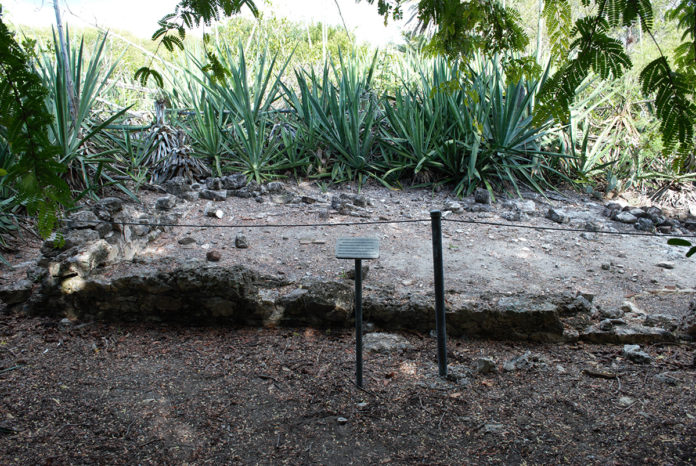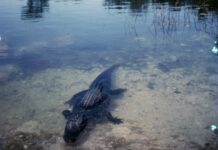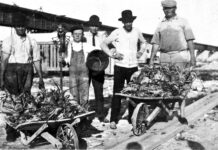
Richard Fitzpatrick served as president of the Florida Territorial Council during the January 1836 session. It was Fitzpatrick who introduced the bill that split Monroe County in two and created Dade County. Because Indian Key was the newly created Dade County’s largest community, it was designated the county seat.
Fitzpatrick would not be the only one in his family to dabble in Dade County politics. Like his uncle, William Fitzpatrick English was the son of wealthy South Carolina plantation owners. English would join the elder Fitzpatrick in Key West and, for a time, worked in his uncle’s salt ponds. At some point, English would become the master of the schooner Brilliant and enter the wrecking industry.
By 1837, English had moved to Indian Key, where he lived in the shadow of the island’s largest structures, two three-story warehouses. At least four buildings were likely associated with the English property: the main house, kitchen, and slave quarters. The kitchen was a free-standing building for good reasons. Among them was the fact that the fire used for cooking produced tremendous heat. Second, it was important to keep the kitchen building separate from the primary home in case of the accidental spread of fire.
The kitchen was built atop a cistern, a valuable resource as there was no other source of fresh water on the island. The cistern would collect rainwater through gutter systems leading from the roof.
Multiple slave quarters would have stood behind the main house for his slaves: Binah English, Lucy English, Chasy English, Mary English, Ellen English and Alexander English.
English was not the island’s only slave owner. Before the Civil War, slave ownership was common. Ten of the country’s first twelve presidents were slave owners, including the fifth president of the United States and Monroe County namesake, James Monroe. The two presidents who were not slave owners were John Adams and his son, John Quincy Adams. On Indian Key, among the island’s other slave owners were Charles Howe, postmaster; S.A. Spencer, proprietor of the Tropical Hotel (the first hotel established in the Florida Keys outside of Key West); and Jacob Housman.
It was July 25, 1837, when Indians attacked Captain John Whalton of the lightship Florida and his crew on Key Largo. Whalton and one crew member were killed. Reports indicate that two wreckers, one being William English from the ship Brilliant, approached the Key Largo site, came ashore and retrieved the bodies. They were taken to Indian Key, where Whalton, according to some sources, was buried.
English followed in his uncle’s footsteps in other ways, too. After Fitzpatrick’s properties along both the Miami and New rivers were abandoned during the second escalation of the Seminole War, English bought them in hopes of reviving the plantations. English moved to the Miami River plantation, where his slaves built two natural stone structures. One of these was a two-story home with three-foot thick walls, built as a home for English. The other was built to house his slaves, many of whom worked in his plantation fields.
English, too, entered the political game. In 1840, English was elected to represent Dade County at the Florida Territorial Congress. He would serve from 1840 to 1844. At the March 1844 meeting of the Territorial Congress, English lobbied to have the county seat moved from Indian Key and relocated to what had initially been called Fort Dallas and later renamed Miami. As Indian Key had been all but abandoned by 1844, the bill passed into law on March 9.
When Indian hostilities reignited with the third escalation of the Seminole War, English, like his uncle before him, abandoned his plantation and returned to the safer confines of Key West. Subsequently, the U.S. Army would take over English’s property, use his stone structures, and reestablish Fort Dallas.
At Key West, English and Uncle Richard bought the schooner Commodore Stockton and decided to sail off on a golden adventure. They sailed south, navigating Cape Horn, Chile, at the last tip of South America, before turning northwest and setting a course for California. Not interested in the beaches, they headed to the northern part of the state, possibly docking at San Francisco before heading inland to the Sacramento area. The hope was to become a part of California’s gold rush, make a fortunate claim and come out of the whole ordeal rich.
As is so often the case, the reality was unable to live up to the dream that had spurred their adventure. While in Grass Valley, California, in 1855, English was riding on a horse. When he went to dismount, his rifle accidentally discharged and the bullet struck him in the side. William English would succumb to the wound and bring an end to his story.

























